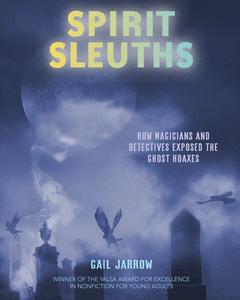
 Sibert Honor winner Gail Jarrow (Spooked!; The Poison Eaters) turns her astute attention to the phenomenon of spiritualism and the investigators who worked to disprove the con. Jarrow's remarkable ability to transform meticulous research into a gripping narrative once again results in a nonfiction work that will transfix readers of all ages.
Sibert Honor winner Gail Jarrow (Spooked!; The Poison Eaters) turns her astute attention to the phenomenon of spiritualism and the investigators who worked to disprove the con. Jarrow's remarkable ability to transform meticulous research into a gripping narrative once again results in a nonfiction work that will transfix readers of all ages.
Jarrow opens Spirit Sleuths in the mid-19th century with the story of the Fox sisters, two girls who claimed they had developed a communication system to talk with the spirit residing in their home. This supposed talent began to grab people's attention, proving especially tempting to vulnerable, grieving people. "During the 1840s--a time before vaccines, antibiotics, and other effective medicines--disease often tragically and prematurely ended lives.... What a comfort to... talk with those who had passed away!" Other spiritualists adopted tools such as spirit cabinets, ghost photos, slate writing, and the Ouija board to profit off the susceptible. Even Harry Houdini started his career with spiritualism. His wife, Bess, played the part of a clairvoyant in the profitable performance, but "Harry came to regret doing them. He realized how deeply his audiences believed in what they heard."
After Jarrow sets the stage with the background on spiritualism and Houdini's experiences with it, she takes readers into Houdini's fight to educate the masses. "He had seen for himself that people who suffered intense grief or had troubled lives often weren't able to think critically.... As a result, many distressed people had been led to make terrible decisions." Houdini worked with the police, wrote articles, did a national lecture tour, and even exposed local mediums during his stage shows. He eventually started employing full-time investigators to supply the information he needed to unmask the fake conjurors. One of these investigators was Rose Mackenberg, a New York City private detective and master of disguise. She worked alongside Houdini until his death; Mackenberg spent more than 30 years as a "ghost detective" and "despite investigating more than a thousand mediums, the spirit sleuth found only frauds."
Jarrow includes detailed insets throughout the book that explain how mediums performed their trickery and how the investigators uncovered the secrets. The book also includes reproductions of news headlines, photographs, and other ephemera from the corresponding time periods. For those craving more, extensive resources appear in the book's back matter. Jarrow continues to work magic in Spirit Sleuths, making certain that young readers can find history accessible, exciting, and surprising. --Jen Forbus, freelancer
Shelf Talker: A Sibert Honor winner beguiles readers as she deftly unveils the secrets of spiritualism and the people who worked tirelessly to debunk it.

